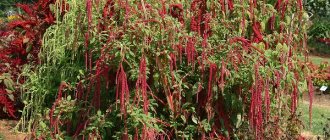Perennial paniculata phlox, or otherwise phlox paniculata, is a tall-stemmed plant with a height of 40 centimeters to 1.5 m. The plant begins to bloom in the summer and continues to produce flowers until autumn. Colors according to the description can be very diverse - white, yellow, pink, red, lilac, purple, salmon and others. Petals can be plain or combine two shades. Flowering is not simultaneous, which allows the plant to remain in bloom for a long time, pleasing the eye and decorating the flowerbed.
Interesting! Each flower lasts about 10 days.
Varieties with photos and names
The culture has many varieties, mostly all tall, perennial shrubs. The flowers differ in size and color. All have a five-petal shape. Another difference between varieties is flowering time. Otherwise, the cultivars are similar: they have the same requirements for agricultural technology, planting time, and methods of reproduction.
Early varieties of paniculata phlox
Early varieties of paniculata phlox include varieties that bloom from late June to mid-July. All of them have a long cycle (within 1.5 months). Their care is the same, but the attitude of the varieties to ultraviolet radiation is different.
Apple blossom
A medium-sized compact bush, peduncles 60-65 cm high. It grows quickly and gains green mass. The inflorescences are dense, the flowers are 4-5 cm in diameter, soft pink, the core is a shade darker. The culture prefers open areas.
Apple blossom is one of the earliest paniculate cultivars
Purple Haze
The height of paniculate phlox is 80-85 cm. The plant forms a spreading bush that holds its shape well and therefore does not require a garter. The inflorescences are large, conical, dense. The flowers are light lilac with a purple center. It blooms at the end of June, the cycle lasts 45 days.
In bright light the color is more saturated, in the shade it appears lighter
Storm
The variety grows up to 1.1 m in height, forms round inflorescences of medium density. The flowers are purple, not a single color; the edges of the petals and the core have purple inclusions. The paniculate culture retains its decorative color only in partial shade.
Important! In the open area, the color fades, the petals are baked along the edges.
Flowering time is long (within 1.5 months), the cycle begins in July
New varieties of paniculata phlox
Breeding work to create new varieties of paniculate phlox with a longer flowering period and colors unusual for the crop is ongoing. Several European novelties that interested designers and florists.
Blue Paradise
Phlox paniculata Blue Paradise is a cultivar with tall peduncles. The bush grows up to 1.2 m in height. The culture forms a wide crown, up to 80 cm in diameter. The inflorescences are dense, densely located, and have the shape of a cone. The flowers are medium-sized, blue-violet, evenly colored.
The flowering period begins in mid-July and lasts about two months
Hesperis
The new variety of paniculate phlox Hesperis is a tall variety, the length of the stems with inflorescences reaches 1.7 m. The shape and color of the inflorescences of the phlox resembles a lilac bush. The petals are dark pink, regular round in shape.
Late variety, the first buds open in the second ten days of August, flowering lasts 50 days
Gray Lady
Gray Lady (Sedaya Dama) is part of the group of smoky varieties of paniculate phlox. The flowers of the variety have a silvery coating, changing the basic dark pink color to various shades. It is difficult to find flowers of the same color in an inflorescence. The bush is dense, tall (up to 70 cm), the inflorescences are round and densely located.
Flowering of the Gray Lady variety is medium late, lasts from July to mid-September
Varieties of paniculata phlox with large flowers
In Phlox paniculata, flowers with a diameter greater than 4.5 cm are considered large. These varieties include: Anna German, Miss Kelly, Sandro Botticelli.
Miss Kelly
The paniculate variety Miss Kelly reaches a height of 1.2 m. The culture is characterized by high stem formation. The flowers are 5 cm in diameter and form a dense spherical inflorescence. The upper part of the bush is covered with flowers with round petals of soft pink color with white fragments at the base.
The flowering period of the Miss Kelly variety is quite long (from July to early September)
Anna German
The paniculate variety has bright salmon-colored petals with darker centers and white areas. The inflorescences are very dense, wide, cone-shaped. Flowering begins in July and lasts 1.5 months.
Variety Anna German medium-sized (up to 80 cm)
Sandro Botticelli
Sandro Botticelli - paniculate phlox of Russian selection. A variety with high decorative qualities is used not only in design, but also in floristry. A bush with straight stems grows up to 70 cm in height. The inflorescences are cone-shaped, formed not at the crown, but from the middle to the very top. Blooms from July.
The flowers of the Sandro Botticelli variety are lilac in color, reach 6 cm in diameter, and are prone to fading
Varieties of white paniculate phlox
White coloring is not typical for the culture; it is a rare variety of paniculate phlox, which does not retain its characteristics during generative propagation. The most popular varieties include: Zephyr, Snow White, Swan Princess.
Marshmallow
The Zefir cultivar is a low-growing herbaceous shrub 65-70 cm high. It blooms from July to September with large rounded inflorescences. The petals are white with pink fragments at the base.
The more acidic the soil composition, the more pink the color of Zephyr petals
Swan Princess
A variety with pure white flowers and a beige core. Petals with pointed tips, star-shaped flower with a diameter of 5 cm. The plant is not tall - 60-65 cm, but with a very thick crown and dense inflorescences.
The buds of the Swan Princess open one by one
Flowering occurs in June.
Snow White
The paniculate variety blooms with white flowers with a yellow core. The inflorescences are so dense and heavy that they bend the stems, so the plant requires staking from July to the end of August.
The height of the Snow White variety is 75-80 cm
Perennial paniculate phlox
Almost all plant varieties are perennial. The rarest and most popular cultivars include the following: Egorka, Success, Bambini Candy Crush.
Egorka
The variety is small-flowered, diameter – 2-2.5 cm. The shape is star-shaped, the color is uneven: the middle and base of the petals are light purple, the edges have a beige-pink tint. The plant is medium-sized – 80 cm. The inflorescences are cone-shaped, very dense, a rare variety, highly decorative.
Egorka blooms for 2 months, starting in June
Success
The perennial cultivar Uspech is 75-85 cm high, characterized by a dense crown and stable stems. The color of the petals is interesting; they are dark purple, with a contrasting white center.
The first buds open in July, the cycle lasts 45 days
Bambini Candy Crush
Highly decorative cultivar Bambini Candy Cruz from Holland is a rare, frost-resistant variety of paniculate phlox. One of the shortest representatives (height 55 cm). The inflorescences are round, compact, formed by large flowers with white and carmine colors.
Bambini Candy Crush flowering period – July-August
Paniculate phlox with red flowers
The most common perennial variety has bright red petals of varying shades. The following varieties are popular among gardeners: Margarita, Miss Mary, Starfire.
Miss Mary
The Miss Mary cultivar, 75-80 cm high, is a compact, dense bush with strong stems that do not require staking. The inflorescences are cone-shaped and lush. The flowers are bright crimson with burgundy fragments at the base. The petals resemble velvet.
The buds bloom in July; the Miss Mary bush retains its inflorescences until the end of August
Margarita
Margarita is one of the brightest representatives of the red paniculate phlox group. The height of the plant is 1.2 m, the diameter of the flowers is 4.5-5 cm, the width of the cone-shaped inflorescences is 25 cm. The petals are pale burgundy with a purple spot at the base.
Margarita is a late variety, the last buds bloom in October
Starfire
The Starfire paniculate phlox group is represented by several cultivars with different variations of red. The classic variety reaches a height of 1 m, has rounded inflorescences formed by bright crimson flowers. Flowering is early, begins in June.
A special feature of the Starfire variety is the concave edges of the petals in the shape of a bowl.
Paniculate phlox with exotic colors
The varieties are rare; they are propagated only vegetatively. Due to their unusual colors, cultivars will decorate any composition:
- Orange Perfection (Orange perfection) height – 75 cm, large-flowered, buds open in July, cycle lasts 2 months. The color is orange with a bright spot by src=»https://agrognom.ru/wp-content/uploads/2020/02/19-2.jpg» class=»aligncenter» width=»624″ height=»529″[/ img] Variety Orange Perfection suitable for cutting
- Sherbet Blend is a rare cultivar with green petals and a bright purple spot at the base. The height of the perennial is 70 cm, the flowers are of medium size, forming round inflorescences. The variety is early, the buds open in June.
With sufficient lighting, the ends of the petals turn lemon-colored. - Gzhel is a variety of Russian selection with large flowers, the petals have one half purple, the other white, the core is burgundy, an early variety.
The height of the Gzhel phlox bush is 90 cm - Dragon belongs to the group of smoky phloxes. This variety is over 60 years old. It is difficult to clearly determine the color; the flowers are variegated. The height of the perennial is 95 cm.
Flowering of the Dragon is mid-early, the duration of the period is 40 days
Description of the species
The difference between paniculata phlox and other varieties of this plant is that the varieties lack the pigment that gives the flowers a yellow tint. The color of the variety varies from white, light blue and pale pink to rich crimson, bright red or purple.
Variety of species
This variety also differs in structure. Paniculate phloxes grow in height from 0.5 to 1.5 m. They have a tall, straight stem, the top of which is decorated with inflorescences. Up to 12-15 buds can be collected on one plant. Flower petals have a smooth or ragged shape. One bud has 5 petals. The leaves are elongated with smooth edges and a pointed tip. They are usually located perpendicular to the trunk in 4 pieces. on the same level.
Phlox paniculata in landscape design + photo
All varieties of paniculate phlox are tall plants, the stems are rigid and stable, the bushes hold their shape well and do not fall apart, so the plant can be planted in any open corner of the garden.
Phlox paniculata is combined with flowering crops of the same height, for example, irises, daylilies, and dahlias.
Advice! It is necessary to choose a color scheme; plants with dark, bright inflorescences are best placed with white, yellow or light pink.
Paniculate phloxes serve as an ideal lining for large conifers or ornamental shrubs. They harmonize well with the dwarf forms of phlox, acting as a central accent in the flowerbed. They look harmonious in a group planting with peonies.
Several examples of the use of crop varieties in the design of a plot or garden:
- They decorate flower beds, creating compositions based on the contrast of flower colors.
Mixborder of daylily and various paniculate varieties - They create improvised hedges.
- Used in a single planting to decorate an empty area.
- Included in compositions with ornamental crops.
- Varieties are planted along the perimeter of fences.
- Planted along garden paths.
Place and soil
Phloxes love good lighting and do not tolerate drafts. The plant feels good anywhere in the area, but it will bloom most luxuriantly if the sun hits it well in the first half of the day, and the rest of the time the light is diffused. Light shading is necessary so that the flower does not get sunburned and does not lose the brightness of its bloom.
Flowers in the flowerbed should be planted away from groundwater
The soil for a flower needs to be moist and nutritious. Groundwater should not be allowed to accumulate near the root system. If the soil is marshy, it is better to provide drainage before planting.
Growing paniculata phlox from seeds
If there are no phlox plants in the garden to collect seeds, purchase planting material. You can sow paniculate phlox directly into the ground and create a greenhouse effect for it. When the seedlings rise by about 5 cm, they are placed at the planting site.
Seedlings are grown from seeds at the end of the growing season.
Attention! This method is more suitable for regions with cold winters.
Phlox paniculata can be grown by planting seeds:
- They are soaked and placed in a damp cloth in the refrigerator.
- Nutrient soil is poured into shallow containers; it can be purchased ready-made or mixed independently from compost and peat.
- Make shallow longitudinal furrows and sow seeds, cover with soil, and moisten abundantly.
- The top of the container is covered with film.
- After the sprouts appear, the covering material is removed and the plants are watered with nitrogen-containing agents.
- When the seedlings reach 15 cm in height, they are planted into separate glasses.
Leave it indoors and water it periodically.
Advice! 2 weeks before planting, seedlings of paniculate phlox are taken to an open area for hardening.
When there is no threat of night frosts, leave them outdoors for 2 days, then plant them.
Landing in a permanent place
Often, planting material is purchased from special nurseries. It is sold in special containers or plastic bags. In this case, the rhizomes are divided and have a small ball of earth on them.
Such planting material can be planted in open ground by adding a mixture of sawdust and peat in early spring.
Another method of planting phlox is available - by seeds. Seed material is sown in open ground in the fall.
Additional Information! Both options are quite effective and simple, since the plant is not demanding or complex in growing technology.
Planting and care
Phlox paniculata is not a fastidious plant. They can develop on any soil composition, but a fully decorative appearance is possible only on a neutral soil composition; slightly acidic soil is allowed. If the soil is poor, it can be corrected by feeding the plant and planting it in a fertile substrate.
The culture is light-loving, but responds quite calmly to periodic shading. It is not recommended to allocate space for paniculata varieties under large trees, on the north side, behind the wall of buildings and in a draft.
Important! For paniculate phlox, a place with stagnant water is unacceptable.
For planting, choose material with a healthy root system. The exposed root is placed in a growth stimulator and antifungal agent for the time specified in the instructions.
Sequence of planting work:
- 7 days before the procedure, dig a hole 30 cm deep and wide.
- The bottom is covered with drainage and fertile soil consisting of compost, sand, turf layer with the addition of complex mineral fertilizer.
- The recess is filled with water.
- On the day of planting, the substrate is slightly loosened so that it is enriched with oxygen.
- They place the seedling according to src=”https://agrognom.ru/wp-content/uploads/2020/02/30.png” class=”aligncenter” width=”603″ height=”385″[/img]
- The root collar is deepened by 2-3 cm.
- The soil around the bush is compacted and watered.
Important! If work is carried out in the fall, the stems are cut so that no more than 10 cm remains above the surface.
After placing paniculate phlox in its place of growth in the spring, the stems are not shortened
How to properly care for phlox
The plant is unpretentious, so it will not cause any trouble for its owner, but it will still require compliance with minimum maintenance conditions.
Trimming and garter
Before the plant survives the winter, it must be properly pruned. The shoots are shortened as much as possible, leaving only a couple of centimeters above the ground surface. In this case, fungi and various bacterial infections do not accumulate between two adjacent shoots. In this case, the mulching process becomes more comfortable and efficient.
Important! As for the garter, it is carried out only for tall varieties. Otherwise, in case of wind or heavy rain, the plant will simply fall to the ground, and sometimes it may even break off.
Flux Trimming
How to prepare a plant for wintering
In order for phlox to survive the winter, it must be cut as short as possible, leaving no more than 5 cm above the ground. Cover with mulch, making the layer sufficiently dense. You can also add fertilizer to the mulch, so the plant will overwinter even better and will immediately delight you with abundant growth in the spring.
Priming
Phlox grows on almost any soil, except swampy and very poor in nutrients.
Therefore, in order to ensure proper growth of the flower, not very nutritious soils should simply be fertilized with organic matter and the correct types of fertilizing should be periodically applied. As for watering, it should be optimal - not to allow moisture to stagnate in the soil, but, at the same time, not to dry out the soil.
Note! If the autumn is dry, then it is necessary to water until the end of October - this way the plant can successfully overwinter.
Feeding
In order for the soil to be as suitable as possible for plant growth, fertilizing should be applied to it twice during the intensive growing season and flowering season.
Nitrogen is used in spring. It is applied to the soil as watering as soon as the shoots rise 10 cm above the soil. To do this, dilute 1 tablespoon of urea per 10 liters of water. Before the phlox puts out buds, it is worth adding humus to the soil in combination with ash and mineral complex fertilizers.
Feeding flux paniculata
As soon as all the stems are cut off in the fall, you need to mulch with organic matter and ash. As can be seen from all of the above, caring for phlox is quite simple.
But it is necessary to take into account that there are also plant diseases.
Features of cultivation
The main care for paniculate phlox consists of watering and fertilizing. Fertilizers are applied during the spring-autumn period:
- at the beginning of the season, products with nitrogen and phosphorus are relevant;
- at the time of budding, liquid organic matter and ammonium nitrate are added;
- During flowering, superphosphate is recommended.
The watering regime is oriented according to seasonal precipitation; paniculate phlox should receive moisture 2 times a week. By autumn, the frequency of watering is reduced, especially before the temperature drops.
Phlox is watered at the root and with an aerosol method at any stage of development, the flowers are not afraid of moisture
If after planting the root circle is covered with mulch, there is no need for loosening, the material prevents the formation of compaction on the soil.
Weeds are removed regularly if they grow next to or under a bush. This measure is aesthetic and preventive in nature. In frequent cases, weeds become the cause of fungal infections.
Protection from diseases and pests
The immunity of paniculate phlox varieties is average; the plant can become infected with temperature fluctuations or lack of nutrition:
- powdery mildew;
- leaf rust;
- variegation.
All diseases are fungal in nature. For preventive purposes, the soil around the plant and the above-ground part is treated with any antifungal agent. If paniculate phloxes show signs of infection, they are sprayed with Ridomil Gold.
The main damage to the plant is caused by the slobbering pennies. To combat the pest, “Commander” is used.
Treatment is carried out twice, maintaining an interval of 14 days.
The appearance of nematodes is less common. In this case, it will not be possible to save the plant; it, along with the roots, will be removed from the site.
Diseases to which phloxes are susceptible
Phlox paniculata is also susceptible to some diseases. Planting and care, chosen correctly, can reduce the risk of plant infection by pathogenic bacteria, but this cannot eliminate the risk completely.
Powdery mildew on phlox leaves
- Rust. Appears in mid-summer. Red-brown spots similar to rust are observed on the leaves and stem of the plant. Subsequently, the number of spots increases, and the leaves become completely covered with them; the plant sheds the affected foliage, starting from the bottom, until it is completely exposed. The disease is combated by spraying the bushes and the soil around them with Bordeaux mixture and a solution of iron sulfate.
- Fomoz. This disease can be recognized by the presence of brown spots on the stem of the plant, which subsequently become loose and crusty and crack. The leaves turn yellow, dry out and fall off. Most often, plants are infected in the second and third years of life. Treatment of this disease is practically unsuccessful and it is better to remove infected plants and take cuttings and planting material only from healthy phloxes.
- Variegation. The most common disease among all phlox varieties. It appears at the moment when plants begin to actively bloom. The disease can be identified by the presence of light-colored radial stripes randomly covering the petals. The carriers of pathogens are most often nematodes and other insects that feed on plant sap. If symptoms are detected, the phlox must be immediately dug up and burned, and the place where it grew must be disinfected.
Phlox affected by bedbugs
Important! Pests love moisture no less than phlox. Mulching the soil will help protect flower beds not only from waterlogging and weeds, but also from some insects.
The main insect pests of phlox are nematodes, thrips and slugs. To combat them, it is necessary to treat both the plants and the soil under them at the planting stage. To combat slugs, it is best to use tobacco dust or wood ash.
Preparing paniculate phlox for winter
Cultivars of paniculate phlox are highly frost-resistant. With proper preparation for winter, an adult plant can withstand up to -35 0C.
Autumn events:
- After the leaves turn yellow and begin to fall off, the flower stalks are removed.
All stems are cut at the root at a height of no more than 10 cm - Potassium and organic fertilizers are applied.
- Cover the tree trunk circle with a layer of mulch (5-7 cm). For the south, these events are enough.
- In regions with low temperatures, spruce branches are placed on top or a structure is made from arcs, and covering material is pulled over it.
Important! If the seedlings are covered with film, it must be removed in early spring so that the roots do not trample.
Plant characteristics
Phlox (lat. Phlox) is a genus of plants belonging to the family Sinyukhova (lat. Polemoniaceae). Phlox gets its name from the Greek word phlox, meaning “flame,” which refers to the bright color of the flowers.
In nature, these plants are found mainly in wet meadows, rocky mountain areas, and sparse forests.
Brief characteristics of the representatives of the genus:
- These are annual or perennial herbaceous plants, sometimes woody at the roots.
- Shoots are erect or creeping, they can be dwarf (10 cm) and tall (more than 1 meter).
- Leaves are usually opposite, short-petioled or sessile, entire, solitary. The shape of the leaf plate varies from round to narrowed.
- The fruits are ovoid or spherical capsules with 3 chambers, containing one or more seeds.
- The flowers are small (3-4 cm in diameter), five-petaled, grouped into inflorescences, although there are species with single flowers. The calyx of the flower is tubular or bell-shaped. The color of the petals is white, yellow, orange-peach, salmon, pink, red, purple, blue. There are two-color petals, with an eye or a contrasting border. It is rare to find terry varieties.
Reproduction methods
Most varieties of paniculate phlox produce seeds that, once planted, retain the external characteristics of the parent plant, so the crop can be propagated generatively. But more often they use the vegetative method. The most productive way is to divide the mother bush. A plant aged 2-3 years with a strong aerial part is suitable for this purpose. After flowering, the bush is divided into several parts and placed on the site.
On each plot leave 2-3 stems and a well-developed part of the root
The varieties can be propagated by layering. In spring, the lower stem is covered with soil, and roots form on it around August. The cuttings are cut into pieces and planted in a designated place; the young plant is well insulated for the winter.
Select a strong stem and fix it to the ground using metal staples
The cutting method is suitable for culture. The material is harvested in May from the upper part of the stems 10-15 cm long. They are placed in a container with water, when the root threads appear, they are determined by the area.
After harvesting, all lower leaves are removed, the crown is cut off, the remaining leaf plates are shortened by a third
What you should know about phlox propagation
This plant can reproduce in several ways. In addition to seeds, it can produce offspring by cuttings or division of the rhizome.
Propagation of phlox by cuttings
Cuttings can be carried out year-round as long as the stem part of the plant is available.
Both roots and stems and leaves are suitable for this process.
Important! If stem cuttings are selected, it is better to take them during the period of bud formation. This will make the rooting process faster.
Cuttings from leaves are best done in the first half of summer. For stem cuttings, choose strong stems without signs of disease damage. They take only the part that has not yet become woody. Each cutting should have two node parts. The lower leaves must be removed without touching the bud. The top ones should be cut in half to reduce moisture loss.
Reproduction of paniculate phlox by dividing the rhizome
With this method, it is necessary to remove the bush from the ground. Divide it into separate parts, choosing only strong rhizomes. Next, the roots must be divided into parts of about 5 cm so that thin root tendrils remain at the lower end.
Next, for both reproduction options you need:
- prepare a box of soil or a suitable area in an open area;
- plant cuttings or rhizomes in well-moistened soil, after making holes in it with a thick peg according to a pattern of 8 by 8 cm;
- It is advisable to sprinkle sand on top;
- the top needs to be moistened again;
- It is advisable to plant cuttings with roots in a separate container and only then plant them in open ground in the spring, when they have taken root well enough.











